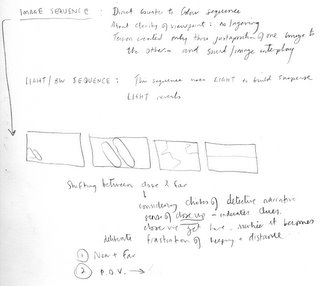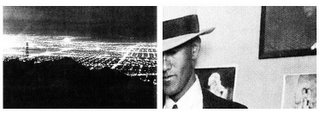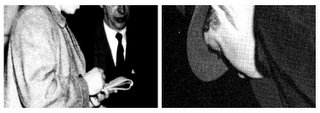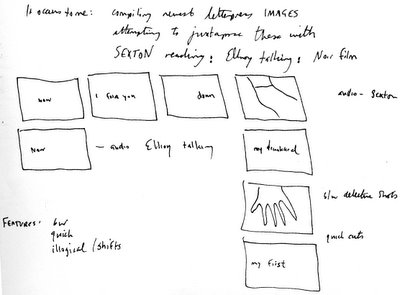Working on a purely black and white image-based mini-sequence for “The Black Dahlia”, I was able to experiment with pre-existing conventions of detective/crime narration. The protagonist’s point of view in a detective narrative is the frame through which the reader/viewer gains access to the story. My adaptation of Ellroy’s novel is very much concerned with my take on detective narratives; that they are about an interplay between the perspective of the detective (as framer of content) and an elusive truth, epitomized by the figure of the murdered woman. My main objective in building this sequence was to primarily convey the perspective of the protagonist, allow us to both see this character, and see what he sees. A secondary interest was to see what I could learn from visual clichés of detective narratives. And the constant underlying interest; how can one imbue a sequence of images with an underlying tension/suspense?


CONSIDERING PROTAGONIST POINT OF VIEW...AND CLICHE
In trying to create the presentation of an‘objective’ point of view, I sensed this was an impossible task. Nevertheless, the objective of this sequence was to provide visual cues to place, character and plot. I opted for archival images presented with no layering; tension was created only through the juxtaposition of one image to another, and the interplay between sound and image.
I approached the creation of a visual language for this sequence in the same way I would pick a tone for a character to speak in. This man is, by appearance at least, a typical homicide detective, his tools are those of interrogation, observation, and deduction. This explains the surface ‘clarity’ of these images in terms of content and presentation.

We see the detective.
We also see what he sees; remnants of the murdered woman:

Still, there is an elusive sense of yearning inherent to this detective character that needed to find a tonal quality in this sequence. This is more a tinge than an actual colour – built through pacing of the images (irregular), cropping of images (also slightly irregular), and the soundtrack. In this way, the character/emotion of this character, and therefore this sequence, is very much under the surface. This is in direct contrast to the layered red sequences – which are pure emotion on the screen.
When attempting to create a visual perspective for the detective protagonist of this story, I began by considering the clichés that operate in many visual adaptations of crime narrative. The most obvious is the use of extreme close-up – both of faces/eyes and forensic evidence. I presume this is done to mimic the intention of the investigator, to get closer, to get inside the truth, to see more clearly. I began to realize this is in direct contrast to the archival crime scene photographs that I have been analyzing – where the focus on the evidence results in the body/centre of attention being on the periphery of the image. These images are usually mid or long shots; presumably to give a clearer perspective of the scene as a whole, rather than one detail. I was curious to explore the shift between near and far in this sequence – cutting from close up and mid-shots of the same image/evidence. This is the beginning of building a type of suspense, the frustration that results from being at a distance from what one wants to see.















